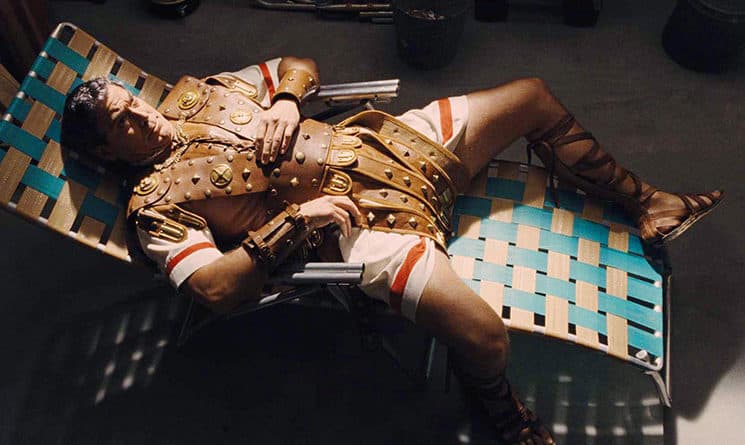Scarlett Johansson as a steamy ingénue with the mouth of a longshoreman. Ralph Fiennes as a well-clipped film director who knows exactly what he wants. Channing Tatum as a gung-ho, tap-dancing sailor. What’s not to love? Then there’s George Clooney as, well, George Clooney — but if George Clooney was the big star of an old-style biblical epic titled “Hail, Caesar!” Which, of course, he is.
The fact that he is on both the poster for the movie you’re watching, as well as the poster for the movie they’re making in the movie you’re watching, also titled “Hail, Caesar!,” should be the first indication that there’s more going on here than the usual Hollywood-takes-on-Hollywood shtick. At first blush, yes, we’re in 1951, and the Coen Brothers’ purely fictional Capital Pictures Studios — last seen portrayed as a virtual hell on earth in their 1991 film, “Barton Fink” — is elbow deep in production of half a dozen cookie-cutter crowd-pleasers.
We follow a no-nonsense studio producer and general Mister Fixit — named after real-life MGM exec Eddie Mannix and played with a grisly, hard-boiled gravitas by Josh Brolin — from lot to lot. Brolin here, by the way, is a dead ringer for classic Hollywood genius Preston Sturges, who once directed a film about making a film called, of all things, “O Brother, Where Art Thou?” (This movie’s in-jokes go so deep they come out the other side.) As he stalks between sets, solving problems, cleaning up messes, and navigating the ever-shifting tangle of egos and idiocy in order to keep the trains running on time, we’re treated, like the opening scene of “Who Framed Roger Rabbit,” to stunning recreations of period staples: an intensely choreographed water ballet, an acrobatic cowboy shoot-’em-up, and a gauzy drawing room romance, among others. Shot with an uncanny eye for accuracy by long-time Coen collaborator Roger Deakins, these scenes bounce and sing and glide. Just as they should.
This full-on, old-school razzle-dazzle could be mistaken as the movie’s entire reason for existing. But, on closer inspection, this is all just fabulously entertaining window dressing for a
much deeper story.
This full-on, old-school razzle-dazzle could be mistaken as the movie’s entire reason for existing. But, on closer inspection, this is all just fabulously entertaining window dressing for a much deeper story. The opening shot, in fact, places the audience squarely in a church. In a blink-and-you’ll-miss-it moment a few minutes later, you’ll see that the full title of the film, as presented on a screen on the screen you’re watching, is in fact, “Hail, Caesar! A Tale of the Christ.”
The Coens’ sleight of hand is inestimable. Though casually presented as a loosely connected series of diverting vignettes, the scenes actually tick together with the precision of a Swiss watch, each cog driving the next forward, weaving with apparently effortless subtlety in and out of themselves: a suspicious valise, a boisterous song-and-dance number about shipping out on a boat with “No Dames,” a soldier who sees the light. The fictions portrayed around Mannix’s search for integrity and moral principle echo out to inform and define the journey itself, even as his story reflects greater truths about accepting higher powers, resisting temptations, and finding one’s center in a world of lowlifes, criminals, and sinners. The Coens have said that their “O Brother, Where Art Thou” (also starring Clooney) was an attempt to adapt Homer’s “Ulysses,” though they themselves had never actually read it. “Hail, Caesar!” may very well be a similar stab at the New Testament.
Like the finest prestidigitation, it’s all played out completely in the open, yet you never notice that they’re doing it. Miracles may happen, the Coens seem to say, but magic is made. When produced well, a good hat-trick, a good entertainment, is always more complicated than it looks. The right hand is always up to something while you’re watching the left. With “Hail, Caesar!,” you may choose to discover higher meanings, deeper truths, and meditate on the role of modern theology. Or you might just be happy to have a damned fun time at the cinema. It’s up to you. Over the years, movies have become a new religion in many ways, but the last word, the Coens tell us — literally — is still “faith,” and that shouldn’t be forgotten.

